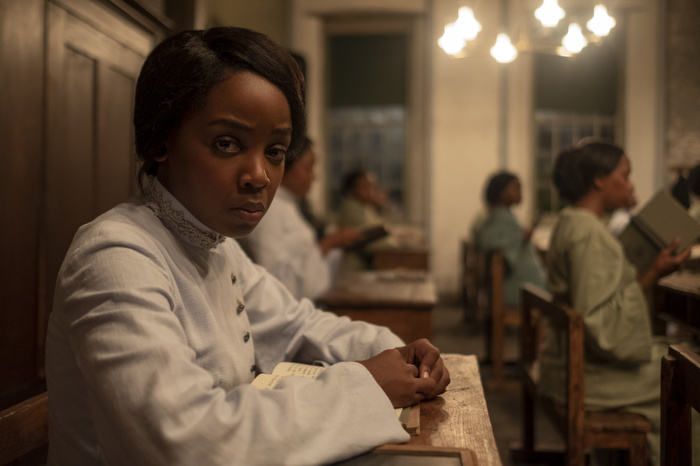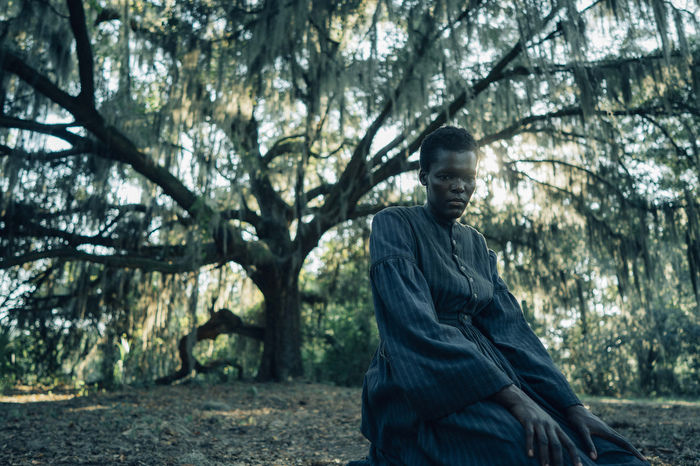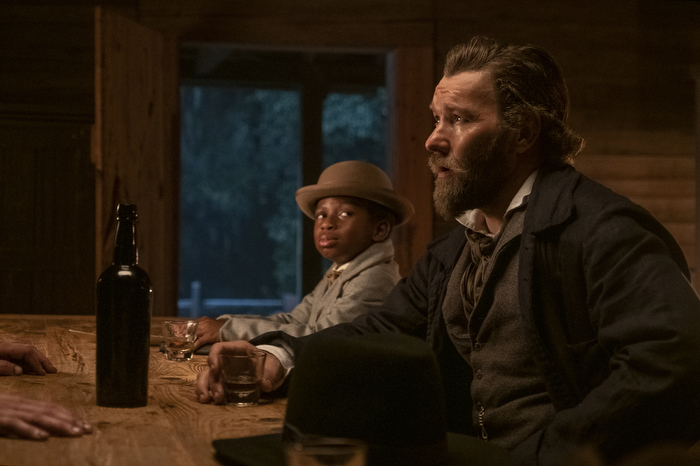
There is a horrible and brilliant scene in the first episode of The Underground Railroad, Barry Jenkins’ breathtaking miniseries adaptation of the Pulitzer-winning novel by Colson Whitehead. A runaway has been captured and returned to a cotton plantation in antebellum Georgia. Stripped to the waist and covered in bleeding lashes, the man (played by Eli Everett) hangs by his wrists from a tall wooden structure. Behind him stand the dozens of enslaved field workers who are being forced to witness his execution. Opposite them, fancily dressed white men and women feast at a table set out in front of the master’s grand house, waited on by enslaved domestics. A pair of Black musicians strike up a jaunty tune as the man is burned alive.
This could be yet another graphic reenactment of Black suffering under slavery, crafted by well-meaning Hollywood types as a reminder—to an implied audience of similarly well-meaning white people with unfeasibly poor memories—of historical racism. Look deeper, though, and the harrowing scene reveals itself an incisive response to pop culture that fetishizes Black people’s pain without acknowledging the psychological impact of such depictions. The same murder that white revelers voluntarily consume as a twisted form of entertainment constitutes a trauma for Black witnesses who have no choice but to look. By sticking close to them, and filming through the victim’s own smoke-fogged eyes, Jenkins makes their perspective paramount. In a work that not only does justice to Whitehead’s masterpiece, but expands it in ways that only television could, he implies that there’s no separating America’s racist origin story from that story’s ongoing exploitation by the American entertainment industry.
The public execution leaves The Underground Railroad’s hero, a young enslaved woman named Cora (South African actor Thuso Mbedu, all desperate intensity), paralyzed in the field. It isn’t her first grave psychic wound. She has already survived abandonment by her mother, Mabel (Sheila Atim), who escaped when Cora was a little girl; rape and other forms of assault are daily realities on the plantation. But it’s the execution that compels her to run away with Caesar (Aaron Pierre), a new arrival who was treated relatively well during his youth in Virginia and refuses to endure the horrors of Georgia. A big, strong, intelligent man who dreams of working with his mind rather than his body, he sees Mabel’s daughter as a good-luck charm. Cora—who in Mbedu’s mesmerizing performance can resemble a scared kid or a frail elder as well as the young adult she is—is too furious, at her mother most of all, to believe she could be anything but cursed. That anger turns out to be a talisman.

In its most dramatic departure from reality, Whitehead’s alternate history imagines the Underground Railroad as a literal subterranean rail system. This conceit underlines, in poetic terms, both the superhuman stealth demanded of real-life fugitives and their abolitionist allies and the latent capabilities of a people who’d been violently prevented from working for their own benefit. “Who built all this?” Cora asks a station agent. “Who built anything in this country?” he replies.
The stations range from functional to luxurious to piles of rubble, and the states they carry Cora through—one in each episode or two—are, as fictionalized by Whitehead and Jenkins, with a nod to Caesar’s beloved Gulliver’s Travels, just as distinct. South Carolina fancies itself an oasis of enlightenment, where Black workers are housed, clothed and fed properly; taught literacy and life skills; treated to social functions; paid in devalued scrip; but still legally enslaved. “North Carolina outlawed Negroes,” Cora is told, chillingly, upon her arrival there. Though her journey isn’t entirely bleak—as long as she’s off the plantation, there’s always hope—each of these states is a different flavor of hell.
In pursuit of the fugitives is the fearsome slave catcher Ridgeway (Joel Edgerton), who failed to apprehend Mabel—now presumed to be outside his jurisdiction in Canada—and sees his obsessive quest to bring her daughter back to Georgia as a chance to settle the score. The character reflects an astute reading of white supremacy in America. Less an ideological bigot than a ruthless, entitled opportunist, Ridgeway isn’t cut out to earn a living through honest labor; instead, he makes a fortune off his aptitude for calmly inflicting pain on enslaved people, whose pursuit of freedom he takes as a personal affront. By his side throughout the journey is the show’s most inscrutable presence, Homer (Chase W. Dillon in a haunting, precocious performance), a quiet Black boy in a dignified suit who maintains an inexplicably fierce loyalty to Ridgeway.
It is a credit to both the book and the show that even the most minor characters here possess enough complexity, and enough resonance within the context of American history, to fuel a novel or miniseries of their own. (Earlier this week, Jenkins released “The Gaze,” a 52-minute video made during the show’s production featuring moving portraits of background actors whose presence, he wrote, gave him the feeling of looking at ancestors “whose images have been largely lost to the historical record.”) Beyond the runaways and their pursuers, we meet a naive white station agent who is blind to the racism roiling beneath the polite surface of his seemingly progressive state, an idealistic couple trying to foster a peaceful Black community, a little runaway girl who lives in a crawlspace and could be Cora in miniature. Some of these stories are interspersed, in both works, with the chapters that follow Cora—and it makes sense that Jenkins departs slightly from the selection of people and events Whitehead emphasizes.

This Underground Railroad, premiering May 14 on Amazon, certainly qualifies as a faithful adaptation, but it’s neither a reverent nor a timid one. Whitehead and Jenkins are very different kinds of artists, the former a minimalist whose spare prose conceals allegories of remarkable depth and the latter an expressionist, infusing trenchant ideas into sounds and images laden with emotion. Through its stylistic restraint, the novel touches on just about every major theme of American history, from eugenics and the double-edged sword of Christian faith to utopian communities and the conflict that so often arises within liberation movements, between respectability politics and radical idealism. At the center of this web is slavery, the original sin.
Masterly as it is on the page, the story might have flattened on the screen into something redundant—a rehash of WGN’s Underground or 12 Years a Slave. But Jenkins uses the medium of serialized television to open up its layers, transcending the specifics of place and period. With roughly two minutes of screen time for every page of text, he’s able to reproduce the book’s most resonant monologues but also insert long, wordless, lyrical passages that communicate characters’ inner lives more elegantly and completely than the voiceover narration so many literary adaptations lean on. Images of fire pervade the miniseries. We observe how its power can be used for good—to shed light, to cook food, to forge tools—but also how easy it is to exploit as a tool of devastating violence and destruction. (Although the show takes place before the Civil War, one environment Cora traverses is a scorched, gray wasteland that simultaneously recalls Sherman’s March to the Sea and activates anxieties about a future climate crisis.) Could there be a more apt metaphor for American exceptionalism?
Thanks to the director’s roster of longtime collaborators—and what was reportedly an enormous budget—each setting has a unique visual and sonic palette that deepens its symbolism. James Laxton, the cinematographer responsible for the singular use of light in Jenkins’ films, captures the almost-physical weight of midday sun beating down on a cotton field. Mark Friedberg, a production designer who worked on some of Wes Anderson’s and Todd Haynes’ most visually stunning projects, deploys color with purpose; a light-green motif in the episode “South Carolina” at first suggests vitality and newness but slowly comes to represent sickness and clinical sterility. “North Carolina” evokes the zealous austerity of America’s founding Puritans, with a town square straight out of a 17th-century colonial settlement complemented by scenes lit like Dutch master paintings—dark as a starless night, save for the menacing glow of a candle or two. Composer Nicholas Britell (of the infinitely meme-able Succession theme) weaves elements native to each landscape, from hissing insects in Georgia to the locomotive’s metal-on-metal clank, into a score held together by muted piano passages.

Superimposed over all of these elements is Jenkins’ greatest contribution to Whitehead’s narrative: a constant awareness that this country has always treated slavery and other anti-Black violence, as well as violence against other oppressed groups (I don’t think it’s a coincidence that the execution scene also calls to mind the Salem witch trials), as entertainment. There is quite a bit of carnage in this series, but it’s never gratuitous. Often, Jenkins turns away from the gory details of a murder or a rape, choosing instead to make viewers watch as an indelible secondhand injury is inflicted on the people forced to witness it.
The filmmaker has confronted the terrible power of such images; he has said, in interviews, that he briefly walked off his own set during the execution scene. The detail reminded me of an episode in which Cora takes a job portraying an enslaved field worker in a diorama at a museum where white children gawk at her through a pane of glass. She is, essentially, reliving her trauma on a loop for the education of an audience that doesn’t acknowledge her humanity, let alone her ordeal. Sometime later, her past life intrudes on the pantomime. It is a frightening moment for Cora. She has to leave her post and run. A white docent works her flight into a story he’s improvising about the daily lives of slaves in places like Georgia. The white patrons clap.
One TV show is not going to end the shameful, centuries-old tradition of Black pain as white entertainment. Instead, The Underground Railroad takes it up as a central theme. So much is happening all at once in this series, yet this aspect of the series carries a particular significance for Hollywood and its customers in an era of racial reckoning. Everyone, even spectators, plays a role in systemic racism’s theater of cruelty. If you’re lucky enough to avoid corporal punishment for the crime of mere existence, you’re either on one side of the gallows, getting traumatized, or the other—being entertained.
More Must-Reads from TIME
- Cybersecurity Experts Are Sounding the Alarm on DOGE
- Meet the 2025 Women of the Year
- The Harsh Truth About Disability Inclusion
- Why Do More Young Adults Have Cancer?
- Colman Domingo Leads With Radical Love
- How to Get Better at Doing Things Alone
- Michelle Zauner Stares Down the Darkness
Contact us at letters@time.com